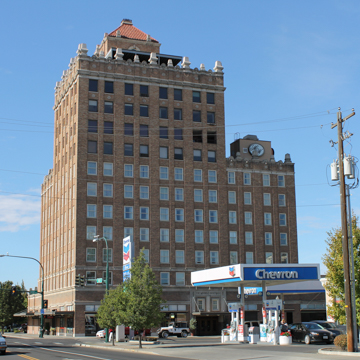The Marcus Whitman Hotel is an oasis of luxury in Walla Walla—the largest city amidst the dryland wheat and grape farming landscape of south-central Washington. Constructed in 1928 at the north end of the downtown business district, today the building includes residential spaces and retail in addition to hotel rooms. At 13 stories, it has offered a commanding presence in Walla Walla’s low-lying skyline since 1929.
The hotel is named for Marcus and Narcissa Whitman, who settled and built a mission near Fort Walla Walla in the vicinity of a native Cayuse Indian settlement in 1836. Slowed because of uneasy native-settler relations, by the 1860s the settlement in Walla Walla grew steadily due to success in dryland wheat farming and a railroad connection. By 1869, the settlement featured the state’s first bank, Baker-Boyer National Bank, and construction began on what would become the Whitman Seminary (renamed Whitman College in 1883). By 1889, Walla Walla’s population had ballooned to 4,500 people, which more than doubled to 10,000 by 1900. Substantial brick and stone buildings began rising in the downtown area, where only wooden structures had existed before.
To accompany this growth, in 1899 the Walla Walla Daily Bulletin ran an editorial angling for a “first class hotel” rivaling those in the larger and more prosperous city of Tacoma on the Puget Sound. The city of Walla Walla, however, would have to wait 28 years for direct action to match its booster desire. In April 1927, Baker-Boyer National Bank President W.W. Baker, along with nearly 200 businesspeople, met to discuss the construction of a luxury hotel to draw travelers and conventions. Baker met with the Real Estate Improvement Company of Seattle, which offered to fund $300,000 of the project if the Walla Walla residents could raise an additional $150,000. To accelerate the fundraising process, he offered residents the opportunity to purchase $100 shares of the company. Just three weeks later, more than 500 residents had purchased shares, and construction began in September. Seattle-based architect Sherwood D. Ford, whose resume included the Italian Renaissance–inspired Fox Theater (1929) and the Washington Athletic Club (1930), both in Seattle, was selected as the architect for what would become the Marcus Whitman Hotel. The Western Construction Company of Seattle was chosen as the general contractor.
The hotel was built of reinforced concrete faced with buff-colored tapestry brick. It has a jagged profile that features 11 floors divided originally into four distinct parts: a 7-story base; a slightly set-back volume that includes floors 8 through 11; a 2-story penthouse with a pyramidal roof (which originally held mechanical equipment and the elevator shaft); and a single-story west wing that housed two dining rooms. Notable street-level features included exterior oak doors and brick pilasters rising to a second-level parapet dividing storefronts on West Rose Street and North Second Avenue. A cast-stone beltcourse delineates the mezzanine, while a more elaborate beltcourse with dentil trim marks the second floor.
Ford’s design overall features classical elements, materials, and treatments broadly suggestive of the Renaissance Revival. This includes columns, pilasters, beltcourses, abundant ornamentation in cast stone and terra-cotta, and a tiled roof with a richly embellished cornice with pilasters punctuated by urn-like crenellations. These elements give the hotel a broad connection to the western architectural tradition, but its mostly flat exterior surfaces, rectangular volumes, and brick facing may have led Ford to interpret his overall gesture as “perpendicular modern.” Ford provided an eclectic interior, with the lobby featuring a terrazzo floor with an urn-and-flower theme; a “Georgian” room with paneled walls featuring seashell motifs; and a banquet room designed in the same urn-and-flower theme of the lobby.
The hotel persevered through the Great Depression, although the population of Walla Walla fell from 25,000 in 1920 to 16,000 by 1932, and did not rebound to 1920 levels until 1960. Important political and cultural figures would later stay at the hotel, including Dwight D. Eisenhower, Lyndon Johnson, Louis Armstrong, and Shirley Temple. By the late 1960s, however, the hotel fell into disrepair and was closed in 1968 due to financial difficulties.
In 1969, in an effort to revive the downtown landmark, William Bremer and Eddie Mays formed The Walla Walla Development Company with a loan of one million dollars. Seeking to diversify the hotel to take advantage of the need for cheaper temporary and long-term lodging accommodations, they added a restaurant and three-story motel on the hotel’s north end, and converted most of the original building into apartments, leaving just two floors of hotel rooms. Yet these conversions did not generate enough revenue to maintain the structure. By the mid-1990s, the Marcus Whitman was again in disrepair.
In 1999, Kyle Mussman formed the Real Estate Improvement Company and bought the hotel. After extensive remodeling, which included the addition of the current retail establishments at the street level and the restoration of many of the original lobby and Georgian room features, the hotel re-opened in 2011. It remains a landmark on the Walla Walla skyline.
References
Kadas, Marianne, “Marcus Whitman Hotel,” Walla Walla County, Washington. National Register of Historic Places Inventory–Nomination Form, 1999. National Park Service, U.S. Department of the Interior, Washington, D.C.
Paulus, Michael J., Jr. “Walla Walla—Thumbnail History.” Essay 8486. HistoryLink.org: The Free Online Encyclopedia of Washington State History, February 26, 2008. Accessed October 29, 2014. www.historylink.org.














